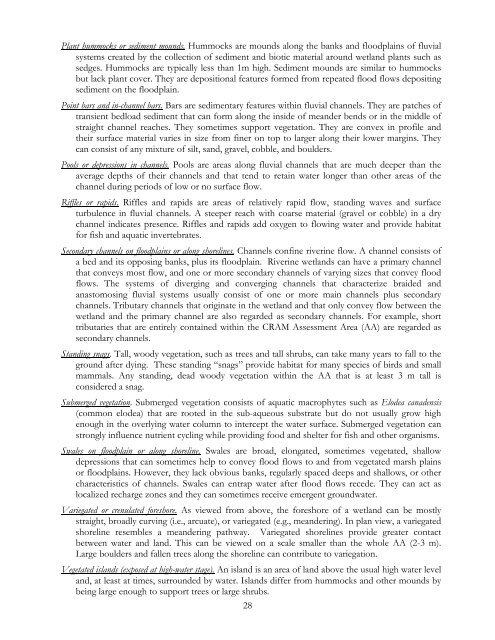You also want an ePaper? Increase the reach of your titles
YUMPU automatically turns print PDFs into web optimized ePapers that Google loves.
Plant hummocks or sediment mounds. Hummocks are mounds along the banks and floodplains of fluvial<br />
systems created by the collection of sediment and biotic material around wetland plants such as<br />
sedges. Hummocks are typically less than 1m high. Sediment mounds are similar to hummocks<br />
but lack plant cover. They are depositional features formed from repeated flood flows depositing<br />
sediment on the floodplain.<br />
Point bars and in-channel bars. Bars are sedimentary features within fluvial channels. They are patches of<br />
transient bedload sediment that can form along the inside of meander bends or in the middle of<br />
straight channel reaches. They sometimes support vegetation. They are convex in profile and<br />
their surface material varies in size from finer on top to larger along their lower margins. They<br />
can consist of any mixture of silt, sand, gravel, cobble, and boulders.<br />
Pools or depressions in channels. Pools are areas along fluvial channels that are much deeper than the<br />
average depths of their channels and that tend to retain water longer than other areas of the<br />
channel during periods of low or no surface flow.<br />
Riffles or rapids. Riffles and rapids are areas of relatively rapid flow, standing waves and surface<br />
turbulence in fluvial channels. A steeper reach with coarse material (gravel or cobble) in a dry<br />
channel indicates presence. Riffles and rapids add oxygen to flowing water and provide habitat<br />
for fish and aquatic invertebrates.<br />
Secondary channels on floodplains or along shorelines. Channels confine riverine flow. A channel consists of<br />
a bed and its opposing banks, plus its floodplain. Riverine wetlands can have a primary channel<br />
that conveys most flow, and one or more secondary channels of varying sizes that convey flood<br />
flows. The systems of diverging and converging channels that characterize braided and<br />
anastomosing fluvial systems usually consist of one or more main channels plus secondary<br />
channels. Tributary channels that originate in the wetland and that only convey flow between the<br />
wetland and the primary channel are also regarded as secondary channels. For example, short<br />
tributaries that are entirely contained within the CRAM Assessment Area (AA) are regarded as<br />
secondary channels.<br />
Standing snags. Tall, woody vegetation, such as trees and tall shrubs, can take many years to fall to the<br />
ground after dying. These standing “snags” provide habitat for many species of birds and small<br />
mammals. Any standing, dead woody vegetation within the AA that is at least 3 m tall is<br />
considered a snag.<br />
Submerged vegetation. Submerged vegetation consists of aquatic macrophytes such as Elodea canadensis<br />
(common elodea) that are rooted in the sub-aqueous substrate but do not usually grow high<br />
enough in the overlying water column to intercept the water surface. Submerged vegetation can<br />
strongly influence nutrient cycling while providing food and shelter for fish and other organisms.<br />
Swales on floodplain or along shoreline. Swales are broad, elongated, sometimes vegetated, shallow<br />
depressions that can sometimes help to convey flood flows to and from vegetated marsh plains<br />
or floodplains. However, they lack obvious banks, regularly spaced deeps and shallows, or other<br />
characteristics of channels. Swales can entrap water after flood flows recede. They can act as<br />
localized recharge zones and they can sometimes receive emergent groundwater.<br />
Variegated or crenulated foreshore. As viewed from above, the foreshore of a wetland can be mostly<br />
straight, broadly curving (i.e., arcuate), or variegated (e.g., meandering). In plan view, a variegated<br />
shoreline resembles a meandering pathway. Variegated shorelines provide greater contact<br />
between water and land. This can be viewed on a scale smaller than the whole AA (2-3 m).<br />
Large boulders and fallen trees along the shoreline can contribute to variegation.<br />
Vegetated islands (exposed at high-water stage). An island is an area of land above the usual high water level<br />
and, at least at times, surrounded by water. Islands differ from hummocks and other mounds by<br />
being large enough to support trees or large shrubs.<br />
28















